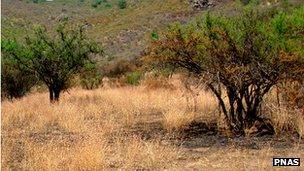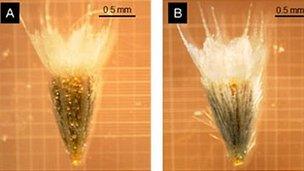Human-induced fires sow the seeds of the future
- Published

The team selected an area that historically had not been exposed to naturally occurring fires
Human-made fires are influencing the evolutionary process of some plant species' seeds, a study has shown.
Scientists found that seeds that were less rounded and coated in thicker protective hairs were more likely to survive fires used to clear scrub.
The study was carried out in an area where natural fires were very rare, allowing the researchers to analyse the impact of human activity.
The results appear in the Proceedings of the National Academy of Sciences, external.
"Our findings provide insights into the understanding of the evolution of seed traits in fire-prone environments and demonstrate that human-made fires can be driving evolutionary changes in plant species from ecosystems where fire does not occur naturally," the researchers wrote.
The study was carried out in an area within Chile's matorral, a Mediterranean eco-region on the nation's west coast.
Playing with fire
Most Mediterranean eco-regions (in southern Europe, California, South Africa, Australia) have a long history of being subject to natural fires, resulting from lightning strikes, yet the central area of the matorral in western Chile is an area where such fires are extremely rare.

The samples from areas that had a greater frequency of human-induced fires had different characteristics
"Macroevolutionary studies indicate that fire has driven the diversification of plant species with seed persistence (fire-resistant or fire-stimulated seed banks) in Mediterranean ecosystems, particularly... where fire has been more frequent or intense," the Chilean scientists explained.
"Nevertheless, we have little knowledge on how fire acts on the variability of seed traits among individuals to drive evolutionary changes in natural populations."
The researchers chose their study area because evidence suggested that fire had not featured in the natural landscape for the past "few million years, probably accounting for the lack of fire-dependent reproduction in matorral flora".
But, they added, that fires in the area - as a result of human actions - had been common since the mid-16th Century as a result of the Spanish colonisation, and had increased even more since the human population expanded during the 19th Century.
To test the idea that human-induced fires were a contributing factor in seed evolutionary processes, the team studied Helenium aromaticum, a native annual herb distributed along Chile's Mediterranean zone.
"We hypothesised that anthropogenic fire has exerted a selective pressure on seed traits of H. aromaticum, so that plants from populations located in habitats with high fire frequency would have smaller, more rounded and pubescent seeds with thicker coverings compared with plants from areas with low fire frequency," they said.
The results showed that there was a positive link between more frequent fires in an area and the characteristics of the seed.
The scientists said that the results indicated that fire was a selective pressure that shaped seed traits, and had more of a defining influence than other environmental factors, such as drought.
"The selection experiment showed that seed pubescence, seed shape and pericarp (outer layers) thickness have an adaptive value," they observed.
"This indicates that human-made fires are changing the... distribution in natural populations by selecting more pubescent, thicker coated and less rounded seeds."
The team added that their finding could be applied globally.
"Under the current global scenario in which fire frequency and intensity are increasing [as a result of] climate change and human activities, the role of anthropogenic fire as a selective agent in ecosystems worldwide is probably underestimated."
- Published17 September 2010
- Published6 June 2010